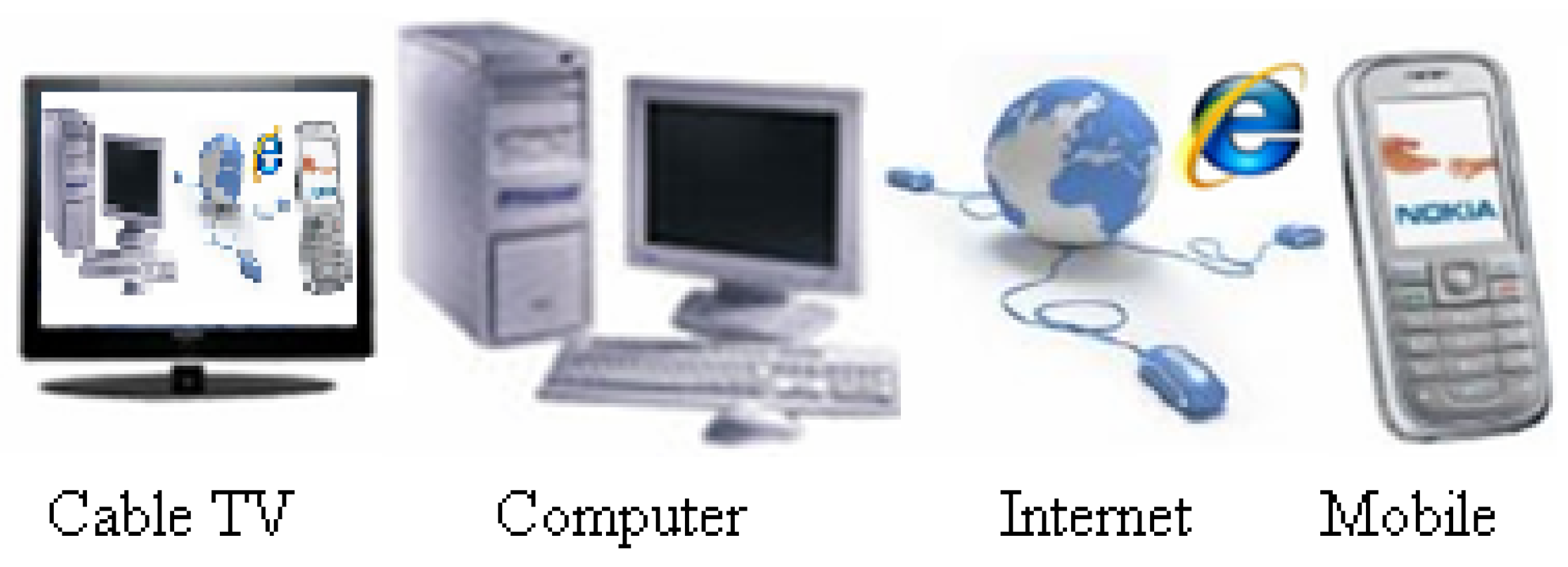Protecting Children in Pakistani Cyberspace: Technology-Religion Education Safety Approach †
Abstract
1. Cyberspace
2. A Mandate to Nowhere
3. Children Protection in Cyberspace
4. Recommendations
- National ICT policy must incorporate UNO existing laws to protect children in cyberspace.
- Children need security in cyberspace as public needs security in daily life.
- A multidisciplinary research is required to protect children and save their time.
- Convene a global children conference to share their bitter experiences in cyberspace.
- Train law enforcement agencies in comprehending, detecting, and punishing ICT criminals.
- Federal and provincial parliaments may design new laws against local and global ICT crimes.
- Advise public to use parental control internet software such as parentalLog, CyberPatrol, CyberSitter and NetNanny etc. to keep an eye on children activities in cyberspace.
- Use filtering devices in schools, homes and Internet cafes to protect children access to ugly web sites.
- Develop chat room monitors to inform parents and law enforcing agencies in a time when children are under attack.
- Public and utility protection may be enhanced by making transparent e-transactions and monitoring electronic intrusions.
- The government may classify and control video games in the market and force CDs sellers to register their business.
- Consider implementing Internet Safety Technical Task Force’s Final Report on Child Safety & Online Technologies.
References
- Khan, N.; Goldwasser, S.M.; Abas, N.; Kalair, A.R.; Haider, A. Experimental investigation of unidentified helium–neon lasers. Appl. Opt. 2017, 56. [Google Scholar] [CrossRef]
- Khan, N.; Mariun, N.; Abas, N. Photon fuelled electric power plants. Lasers Eng. 2008, 18, 383–401. [Google Scholar]
- Khan, N.; Saleem, Z.; Abas, N. Endorsement of new SI unit prefixes for space, time, energy and matter. Lasers Eng. 2008, 18, 107–118. [Google Scholar]
- Khan, N.; Abas, N. Smart Crime science and Shabby Control Technologies. VFAST Trans. Educ. Soc. Sci. 2015, 6, 55–71. [Google Scholar]
- Khan, N.; Abas, N.; Kalair, R. Electronic and Photonic Communiqué Bottlenecks Mandate Ultrafast Optics. Nonlinear Opt. Quantum Opt. 2017, 48, 185–192. [Google Scholar]
- Khalil, H.B.; Abas, N. Smart grids: An approach to integrate the renewable energies and efficiently manage the energy system of Pakistan. In Proceedings of the International Conference on Computing, Communications and Networking Technologies, 11–13 July 2014. [Google Scholar] [CrossRef]
- Khan, N.; Abas, N.; Kalair, A.; Saleem, M.S. Experimental Study of Optical Fiber Conditions in Service on Data Communication. Nonlinear Opt. Quantum Opt. 2017, 48, 225–235. [Google Scholar]
- Khan, N.; Abas, N.; Kalair, A. Design of an Optical Clock Repetition Rate Multiplier. Nonlinear Opt. Quantum Opt. 2016, 48, 17–28. [Google Scholar]
- Ahmad, M.R.; Khan, N.; Hoong, C.C.; Abas, N. Remote data acquisition through internet based telemetry. In Proceedings of the Student Conference on Research and Development (SCORED 2003), Putrajaya, Malaysia, 25–26 August 2003. [Google Scholar] [CrossRef]
- Yasmin, M.; Sohail, A.; Mangrio, R.A. Myths Broken or Sustained: Representation of Women Victims in Pakistani Media. Open J. Soc. Sci. 2015, 3, 209–219. [Google Scholar] [CrossRef][Green Version]
- Yasmin, M.; Sohail, A. A creative alliance between learner autonomy and English language learning: Pakistani University teachers’ beliefs. Creatvity Studies 2018, 11, 1–9. [Google Scholar] [CrossRef]
- Yasmin, M.; Naseem, F.; Raza, M. Creative marginalization of gender: a discourse analysis of advertisements in Pakistani newspapers. Creativity Studies 2018, 11, 152–161. [Google Scholar] [CrossRef]


Publisher’s Note: MDPI stays neutral with regard to jurisdictional claims in published maps and institutional affiliations. |
© 2018 by the authors. Licensee MDPI, Basel, Switzerland. This article is an open access article distributed under the terms and conditions of the Creative Commons Attribution (CC BY) license (https://creativecommons.org/licenses/by/4.0/).
Share and Cite
Abas, N.; Naseem, F.; Kalair, A.R.; Saleem, M.S. Protecting Children in Pakistani Cyberspace: Technology-Religion Education Safety Approach. Proceedings 2018, 2, 1366. https://doi.org/10.3390/proceedings2211366
Abas N, Naseem F, Kalair AR, Saleem MS. Protecting Children in Pakistani Cyberspace: Technology-Religion Education Safety Approach. Proceedings. 2018; 2(21):1366. https://doi.org/10.3390/proceedings2211366
Chicago/Turabian StyleAbas, Naeem, Farhat Naseem, Ali Raza Kalair, and Muhammad Shoaib Saleem. 2018. "Protecting Children in Pakistani Cyberspace: Technology-Religion Education Safety Approach" Proceedings 2, no. 21: 1366. https://doi.org/10.3390/proceedings2211366
APA StyleAbas, N., Naseem, F., Kalair, A. R., & Saleem, M. S. (2018). Protecting Children in Pakistani Cyberspace: Technology-Religion Education Safety Approach. Proceedings, 2(21), 1366. https://doi.org/10.3390/proceedings2211366




